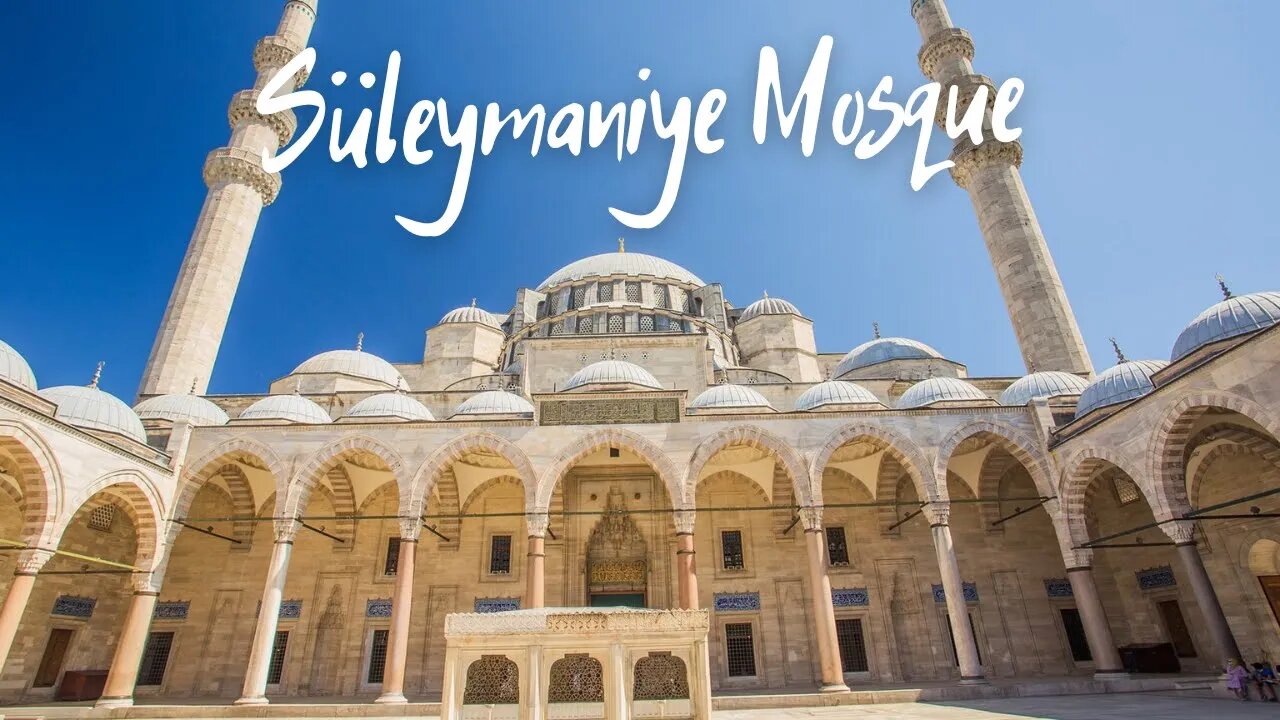Premium Only Content

Süleymaniye Mosque | Istanbul | Turkey | 2023
The Süleymaniye Mosque (Turkish: Süleymaniye Camii, pronounced [sylejˈmaːnije]) is an Ottoman imperial mosque located on the Third Hill of Istanbul, Turkey. The mosque was commissioned by Suleiman the Magnificent and designed by the imperial architect Mimar Sinan. An inscription specifies the foundation date as 1550 and the inauguration date as 1557. Behind the qibla wall of the mosque is an enclosure containing the separate octagonal mausoleums of Suleiman the Magnificent and his wife Hurrem Sultan (Roxelana). For 462 years, the Süleymaniye Mosque was the largest mosque in the city, until it was surpassed by the Çamlıca Mosque in 2019. The Süleymaniye Mosque is one of the best-known sights of Istanbul, and from its location on the Third Hill, it commands an extensive view of the city around the Golden Horn.
History
Elevation and plan published by Cornelius Gurlitt in 1912
Sultan Suleyman the Magnificent chose the architect Mimar Sinan to create a mosque in memory of his son Şehzade (Crown Prince) Mehmed. Suleyman was so impressed with the ensuing Şehzade Mosque (Şehzade Cami) that he asked Sinan to design a mosque for himself too. This mosque would represent the pre-eminence of the Ottoman Empire. In designing the Süleymaniye Mosque, Sinan took inspiration from the Hagia Sophia and the Bayezid II Mosque. The mosque was built on the site of the old palace (Eski Saray) of Topkapi which was still in use at the time and had to be demolished.
The Arabic inscription above the north portal of the mosque is carved in Thuluth script on three marble panels. It gives a foundation date of 1550 and an inauguration date of 1557. In reality the planning of the mosque began before 1550 and parts of the complex were not completed until after 1557.
The design of the Süleymaniye played on Süleyman's self-conscious representation of himself as a 'second Solomon.' It referenced the Dome of the Rock, which was built on the site of the Temple of Solomon in Jerusalem, as well as Justinian's boast upon the completion of the Hagia Sophia: "Solomon, I have surpassed thee!" The Süleymaniye asserted Süleyman's historical importance although it was smaller in size than Hagia Sophia.
The Süleymaniye was damaged in the great fire of 1660 and was restored by Sultan Mehmed IV. Part of the dome collapsed during the earthquake of 1766. Subsequent repairs damaged what was left of Sinan's original decoration (recent cleaning has shown that he experimented with blue, before making red the dominant colour of the dome).
During World War I the courtyard was used as a weapons depot, and when some of the ammunition ignited, the mosque suffered another fire. Not until 1956 was it fully restored again. The mosque was restored again between 2007 and 2010. Parts of the surrounding complex continued to be restored in the decade following.
Architecture
Exterior
Like the other imperial mosques in Istanbul, the entrance to the mosque is preceded by a forecourt with a central fountain. The courtyard is of exceptional grandeur with a colonnaded peristyle with columns of marble, granite and porphyry. The northwest facade of the mosque is decorated with rectangular Iznik tile window lunettes. It was the first building in which the Iznik tiles included the brightly coloured tomato red clay under the glaze.
Four minarets occupy the four corners of the courtyard. The two taller ones have three galleries (serifes) and rise to a high of 63.8 m (209 ft) without their lead caps and 76 m (249 ft) including the caps. Four minarets were added to mosques endowed by a sultan (princes and princesses could construct two minarets; others only one). The minarets have a total of 10 galleries, which is said to reflect the fact that Suleiman I was the 10th Ottoman sultan.
The main dome is 53 metres (174 feet) high and has a diameter of 26.5 metres (86.9 feet) which is exactly half the height.[13] When it was built, it was the highest dome in the Ottoman Empire, when measured from sea level, although it was still lower from its base and smaller in diameter than that of Hagia Sophia.
Interior
The interior of the mosque is almost a square measuring 59 metres (194 feet) in length and 58 metres (190 feet) in width, forming a single vast space. The dome is flanked by semi-domes, and to the north and south there are arches with tympana-filled windows, supported by enormous porphyry monoliths. Sinan embarked on a radical architectural innovation to mask the huge north–south buttresses needed to support these central piers - he incorporated the buttresses into the walls of the building, with half projecting inwards and half projecting outwards, and then hid the projections by building colonnaded galleries. There is a single gallery inside the structure, and a two-story gallery outside.
-
 LIVE
LIVE
The White House
2 hours agoPresident Trump Hosts First Cabinet Meeting, Feb. 26, 2025”
2,259 watching -
 DVR
DVR
The Dan Bongino Show
2 hours agoShake-Up In The White House Press Room (Ep. 2431) - 02/26/2025
329K455 -

The Rubin Report
1 hour agoDem Looks Visibly Angry as Stephen A. Smith Points Out Failures to His Face
9.2K8 -
 LIVE
LIVE
Benny Johnson
1 hour ago🚨 FBI Launches INVESTIGATION Into James Comey for Illegal Spying on Trump | WH Cabinet Meeting LIVE
9,283 watching -
 LIVE
LIVE
Steven Crowder
3 hours ago🔴 Trump Keeps Delivering | This Week’s 3 Big Wins Explained
31,576 watching -
 LIVE
LIVE
LFA TV
15 hours agoFLUSHING THE TURDS! | LIVE FROM AMERICA 2.26.25 11AM
4,320 watching -
 1:07:54
1:07:54
Timcast
2 hours agoTulsi FIRED 100+ Deep State PERVS After Fed Kink Chat EXPOSED, Trump CLEANS HOUSE | Timcast LIVE
100K24 -
 LIVE
LIVE
Bannons War Room
8 days agoWarRoom Live
20,195 watching -
 LIVE
LIVE
House Committee on Energy and Commerce
4 days agoO&I Hearing: Examining the Biden Administration’s Energy and Environment Spending Push
247 watching -
 2:10:18
2:10:18
Matt Kohrs
13 hours agoThe Crypto Crash, Stock Bounce & Breaking News || The MK Show
44.3K3